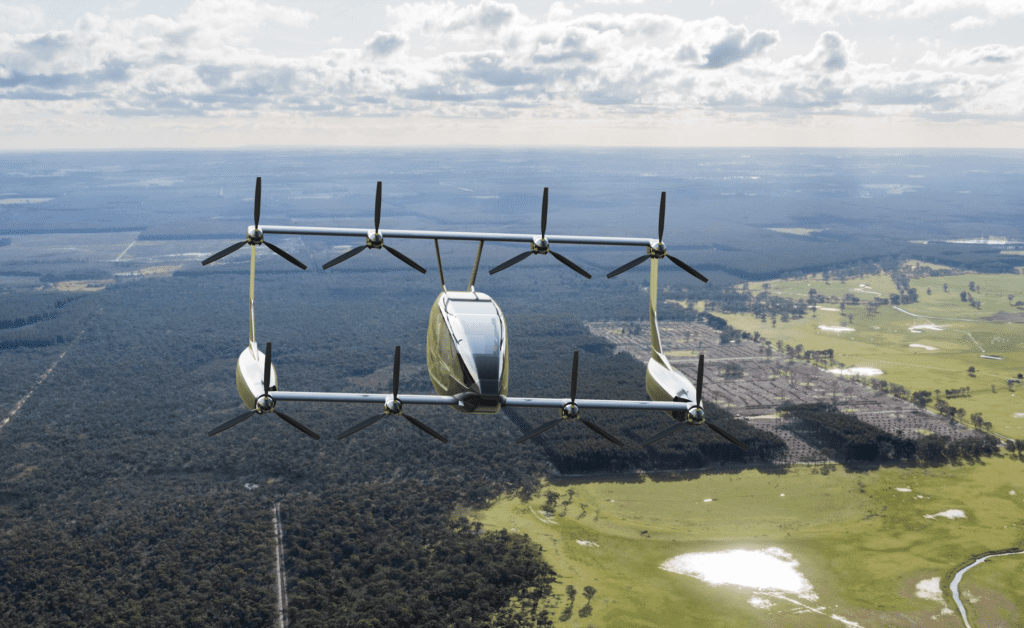
eVTOL developer AMSL Aero is one of 15 partners working in collaboration through the Greenbird initiative to support advanced air mobility in Australia. (Photo: AMSL Aero)
A collaboration of aviation organizations and Australian businesses called Greenbird, working to support advanced air mobility, just added its 15th ecosystem partner this week. Greenbird is led by aviation consulting firm AVISTRA, and partners include Skyports (UK), Nautilus Aviation, Electro.Aero, and Griffith University, along with many others.
“Australia has a great climate for VFR flying,” Greenbird’s Managing Director, Sara Hales, told Avionics International. Australia also offers “a globally respected aviation regulator, relative political stability and a market with the capacity to pay for an air mobility solution to what are genuine and existing mobility challenges, particularly regionally,” she added. “Many of the use case scenarios present in Australia are also operationally less complex than those in other major cities around the world. This creates a comparatively unconstrained environment to explore the safety and capabilities of new technologies for advanced air mobility (AAM).”
The company Quickstep, an independent aerospace composite manufacturer, is the latest to join Greenbird. Quickstep provides support to aircraft manufacturers and operators including Boeing, the Qantas Group, Lockheed Martin, and Northrop Grumman.

Steve Osborne, Quickstep Applied Composites Executive General Manager, said, “This rapidly growing aviation sector has aerospace manufacturing at its core and provides a massive opportunity for Quickstep and the broader Australian supply chain, from manufacturing through to aircraft operations. The work the Greenbird team is doing is critical to ensuring Australia keeps pace with this global aviation revolution.” (Photo: Quickstep)
The Greenbird initiative is currently in the process of strategy development, the first phase of the AAM Flight Plan 2035. “[We are] engaging with industry and government in order to establish a conversation and narrative around not only the operationalization and regulation of the industry, but also its transition to commercial service provision,” Hales explained.
Greenbird’s partners will work to address challenges related to the commercialization of AAM in Australia by developing project-based approaches. Greenbird’s Strategy and Implementation Plan, once finalized, will recommend government initiatives to attract investment in the AAM industry and suggest necessary regulatory developments.
Swan River Seaplanes, a tourism aircraft operator, joined the collaboration for AAM just a couple of weeks ago. At the end of June, Australian aircraft maintenance, repair, and overhaul organization Sigma Aerospace also became a partner of the Greenbird effort. AMSL Aero is an electric vertical take-off and landing (eVTOL) aircraft developer that became a partner of Greenbird in March, along with Skyports, a company designing and developing vertiports.
Nautilus Aviation was one of the first partners to join the Greenbird collaboration platform. Nautilus, which became a partner in February, operates a fleet of helicopters for applications ranging from commercial and emergency services to leisure and tourism. The company has also ordered 10 eVTOL aircraft from Eve with the expectation of starting tourist flights via eVTOLs in 2026 or earlier.

“There’s still a lot of work to do to truly understand the business case and optimum use case scenario for the aircraft and supporting infrastructure in Australia,” said Greenbird’s Sara Hales. Pictured above is the eVTOL model from one of Greenbird’s partners, the eVTOL developer Nautilus. (Photo: Nautilus Aviation)
In conjunction with industry stakeholders, Greenbird has set a goal of beginning early autonomous operations in 2032, when Queensland will host the Olympics in Brisbane. Hales remarked that this is one of the best opportunities for OEMs to showcase novel technologies. “The challenge for Australia, however, is to take control of the opportunity to design and facilitate an AAM ecosystem and industry which meets the ongoing and unique needs of Australian communities in a commercially, socially and environmentally sustainable way,” she said. “We have a major investment attraction opportunity—let’s leverage it for the good of Australia’s people and communities.”
This 2032 goal of early autonomous operations may change as Greenbird continues to evaluate its strategy. One hurdle is attracting interest from some of the biggest OEMs and other AAM industry players to bring commercialization projects to Australia. Hales commented, “We foresee other challenges around issues like city planning, infrastructure provision and integration, electricity supply, social issues around noise, privacy and social amenity, as well as the need to build a social license to operate, and a feeling of trust and confidence in the safety of the mode.”
Australia’s Civil Aviation Safety Authority, or CASA, recently published a regulatory roadmap for drones and AAM. Hales and the Greenbird team believe that this roadmap is a step in the right direction, describing CASA’s approach as pragmatic and collaborative. “We do hold concerns around advanced air mobility being referred to as an extension of the drone sector,” Hales said. “Amongst other layers of government, there can be a tendency to think of AAM as an extension of drones. However, we take the view that this is an extension of aviation.
“AAM will use the same regulatory frameworks and regulators as aviation, it will operate in the same commercial passenger business case context, and largely, the first movers are current aircraft operators.”
The first phase of the AAM industry will involve existing industry operators, operating in the existing environment, and flying VFR missions with new electric-powered helicopters, according to Hales. Following this initial phase, “we will see an evolution of the complexity of the flying mission and its environment as well as a transition towards hybrid and hydrogen propulsion systems and remotely piloted and autonomous flight.”